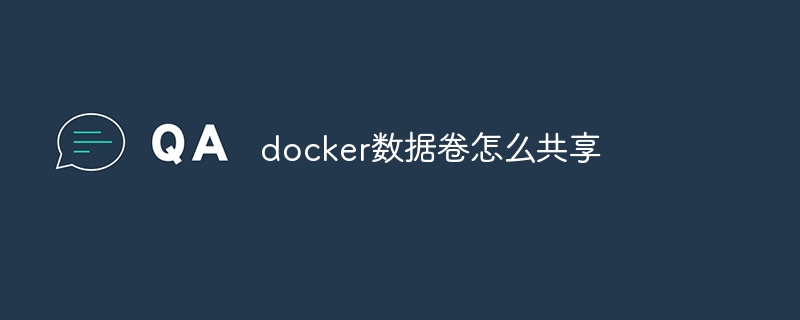How to share docker data volumes
Shared data volumes allow multiple containers to access the same data. The steps include: creating a data volume, mounting the data volume to a container, and copying the same data volume to another container. Notes include: All changes to the container are immediately visible, with the same permissions, and compatibility. Example: Create a database file data volume, mount it to database and web containers, so that they can both access the database files.

How to share Docker data volumes
Introduction
In Docker, data volumes are used to persistently store data between containers and hosts. Shared data volumes allow multiple containers to access the same data.
Steps
In order to share a data volume, the following steps are required:
1. Create a data volume
Create a data volume using docker volume create create command. For example:
<code>docker volume create shared-data</code>
2. Mount the data volume to the container
Use the -v ( --volume ) option to mount the data volume to the container. For example:
<code>docker run -v shared-data:/data my-image</code>
3. Copy the same data volume to another container
mount the same data volume to another container by using the -v option again. For example:
<code>docker run -v shared-data:/data another-image</code>
Things to note
- All container changes to data are immediately visible when sharing a data volume.
- Make sure all containers have the same permissions to the data volume.
- Different containers may use different data formats, so verify compatibility before sharing data volumes.
Example
Suppose there are two containers, web and database . To share a data volume containing a database file, you can do the following:
- Create a data volume:
<code>docker volume create my-data</code>
- Mount the data volume to
databasecontainer:
<code>docker run -v my-data:/var/lib/db my-database-image</code>
- Mount the same volume to the
webcontainer:
<code>docker run -v my-data:/var/www/html my-web-image</code>
Both web and database containers will now be able to access database files stored in my-data data volumes.
The above is the detailed content of How to share docker data volumes. For more information, please follow other related articles on the PHP Chinese website!

Hot AI Tools

Undresser.AI Undress
AI-powered app for creating realistic nude photos

AI Clothes Remover
Online AI tool for removing clothes from photos.

Undress AI Tool
Undress images for free

Clothoff.io
AI clothes remover

Video Face Swap
Swap faces in any video effortlessly with our completely free AI face swap tool!

Hot Article

Hot Tools

Notepad++7.3.1
Easy-to-use and free code editor

SublimeText3 Chinese version
Chinese version, very easy to use

Zend Studio 13.0.1
Powerful PHP integrated development environment

Dreamweaver CS6
Visual web development tools

SublimeText3 Mac version
God-level code editing software (SublimeText3)

Hot Topics
 1393
1393
 52
52
 37
37
 110
110
 How to update the image of docker
Apr 15, 2025 pm 12:03 PM
How to update the image of docker
Apr 15, 2025 pm 12:03 PM
The steps to update a Docker image are as follows: Pull the latest image tag New image Delete the old image for a specific tag (optional) Restart the container (if needed)
 How to exit the container by docker
Apr 15, 2025 pm 12:15 PM
How to exit the container by docker
Apr 15, 2025 pm 12:15 PM
Four ways to exit Docker container: Use Ctrl D in the container terminal Enter exit command in the container terminal Use docker stop <container_name> Command Use docker kill <container_name> command in the host terminal (force exit)
 How to copy files in docker to outside
Apr 15, 2025 pm 12:12 PM
How to copy files in docker to outside
Apr 15, 2025 pm 12:12 PM
Methods for copying files to external hosts in Docker: Use the docker cp command: Execute docker cp [Options] <Container Path> <Host Path>. Using data volumes: Create a directory on the host, and use the -v parameter to mount the directory into the container when creating the container to achieve bidirectional file synchronization.
 How to restart docker
Apr 15, 2025 pm 12:06 PM
How to restart docker
Apr 15, 2025 pm 12:06 PM
How to restart the Docker container: get the container ID (docker ps); stop the container (docker stop <container_id>); start the container (docker start <container_id>); verify that the restart is successful (docker ps). Other methods: Docker Compose (docker-compose restart) or Docker API (see Docker documentation).
 How to use docker desktop
Apr 15, 2025 am 11:45 AM
How to use docker desktop
Apr 15, 2025 am 11:45 AM
How to use Docker Desktop? Docker Desktop is a tool for running Docker containers on local machines. The steps to use include: 1. Install Docker Desktop; 2. Start Docker Desktop; 3. Create Docker image (using Dockerfile); 4. Build Docker image (using docker build); 5. Run Docker container (using docker run).
 How to view the docker process
Apr 15, 2025 am 11:48 AM
How to view the docker process
Apr 15, 2025 am 11:48 AM
Docker process viewing method: 1. Docker CLI command: docker ps; 2. Systemd CLI command: systemctl status docker; 3. Docker Compose CLI command: docker-compose ps; 4. Process Explorer (Windows); 5. /proc directory (Linux).
 How to check the name of the docker container
Apr 15, 2025 pm 12:21 PM
How to check the name of the docker container
Apr 15, 2025 pm 12:21 PM
You can query the Docker container name by following the steps: List all containers (docker ps). Filter the container list (using the grep command). Gets the container name (located in the "NAMES" column).
 How to start mysql by docker
Apr 15, 2025 pm 12:09 PM
How to start mysql by docker
Apr 15, 2025 pm 12:09 PM
The process of starting MySQL in Docker consists of the following steps: Pull the MySQL image to create and start the container, set the root user password, and map the port verification connection Create the database and the user grants all permissions to the database




